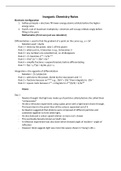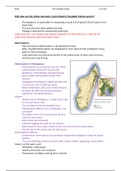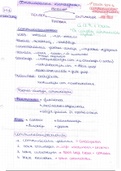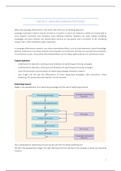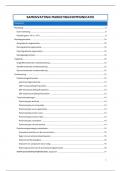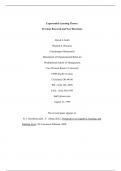ECS2603
CHAPTER 1
1.1 ECONOMIC INDICATORS.
Economic indicators only indicate something if compared to something else.
Reasons for monitoring indicators:
To expand business and explore new markets
Asses general performance of the economy
Effectiveness of economic policy
Compare economic policies between countries.
Make economic forecasts
Speculators monitor to decide whether to buy or sell socks.
‘Pure’ economic indicator terms:
Gross Domestic Products (GDP)
Rate of economic growth
Consumer price index (CPI)
Producer price Index (PPI)
Inflation rate
The money stock
Balance of payments
Exchange rates
Budget deficit
National Debt
1.2 ASSESING THE PERFORMANCE OF THE ECONOMY
At the microeconomic level the following objectives usually serve as criteria for judging the state of the economy:
Economic Growth: How does one measure performance of the economy in relation to the growth target
Full Employment: How is the employment performance of the economy measured?
Price Stability: Inflation how is it measured? What is an index, how are they calculated?
Balance of Payments Stability: What is the BOP? What is the significance of the subaccounts of the BOP?
An Equitable Distribution of Income: How to assess the distribution of income and techniques?
1.3 SOURCE OF ECONOMIC DATA.
The main sources of the South African economic data and data required to make comparisons. Two most important agencies
which collect economic data in SA are Statistics South Africa (Stats SA) and the South African Reserve Bank (SARB).
Stats SA is the central government body in SA that is authorised in terms of the Statistics Act to compile and publish national
statistics.
SARB Quarterly Bulletin: Best known and most frequently quoted data sources and contains economic data only. It
contains an extensive summary and interpretation of recent economic developments, including short-term policy.
Greater part consists of 150+ statistical tables covering most aspects of SA economy.
SARB Annual Report: This incorporates the Annual Economic Report which contains a review of economic and financial
conditions during the past 12 months. Data is presented as ratios in rate of changes.
Release of Selected Monthly Data: SARB updates monthly money and banking and other stats by issuing a brief Release
Selected Monthly Data.
South African Statistics: This is the most comprehensive collection of annual South African data.
Bulletin of Statistics: Regular quarterly publication of Stats SA which can be used to update South African Statistics.
P Series or Statistical Releases: When data becomes available between the Bulletin of Statistics and South African Statics,
SARB publishes the P Series.
Stats in Brief: Annual release pocket guide containing data on 18 different topics.
Quarterly Labour Force Survey: Contains the results of rotating panels household survey specifically designed to measure
the dynamics of employment and unemployment in the country.
Budget Review: Published by treasury to coincide with the Minister of Finance Budget speech.
Secondary Data Sources: Data supplied by firms who specialise in providing economic data and making them available to
end users.
International Economic Data: The IMF, World Bank and United Nations regularly collect and publish data for all countries.
Useful source is the International Financial Statistics from the IMF contains data of all IMF countries on exchange rates,
international liquidity, banking, trade and prices and national accounting data.
1|Page
,1.4 INTERPRETING ECONOMIC DATA
Interpreting data requires an understanding of the data, knowledge of which data to use and an awareness of the limitations of
the data. Here below are basic hints when economic data is being interpreted.
The definitions the indicators should always be checked carefully
Determine the period to which the data relates.
Always make sure data is seasonally adjusted.
Always check whether the variable is a stock or flow.
Ascertain the geographic coverage of the data.
Check if the data has been adjusted for inflation.
Check who produced the data, government or private company.
Many time data is not collected but arise as a by-product of some administrative process.
Check whether the data will be revised or if still needs to be revised.
For observations over time, it may be useful to plot the data on a graph.
Ascertain the start and end points for calculating changes.
A frequent mistake is to confuse levels with rates of change (or percentages).
Determine what other yard sticks will aid interpretation.
Bear in mind that correlation does not result in causation.
Be cautious of international interpretations as definitions may differ between countries.
1.5 SOME BASIC CONCEPTS AND TECHNIQUES.
Volume, price and value.
Value (PQ) = price (P) x quantity (Q)
Or
Volume (Q) = value (PQ) / price (Q)
Real and nominal values.
Unadjusted original values are expressed at current prices in Nominal Terms. The current price (nominal) data are then deflated
by a price index to obtain Constant Price or Real Data.
Nominal value = PQ
Real value = Q = PQ/P
Percentages
The percentage difference between two numbers is calculated by expressing the absolute difference between the two numbers as
a ration of the original number.
Percentages, percentage points and basis points.
In the financial markets each percentage points consists of 100 basis points. E.g. 100 or 50 basis points.
Levels and rates of change.
There is a tendency to confuse levels with rates of change when interpreting economic data. I.e. A high level should not be
confused with a high rate of change.
Stocks, flows and ratios.
A stock has no time dimension and is measured at a specific point in time.
A flow is measured over a period of time, irrespective of how short.
Stocks – Capital stock, money stock, saving balance and wealth of an individual.
Flows – production, spending, income, investment, consumption and saving.
Averages.
A single number which expresses the central or representative value of the data. i.e. Measure of central tendency
Simple average or arithmetic mean is the sum of values divided by the number of values.
Weighted Averages - calculated when the different observations are not equally important. This is important when price indices
and other indices are compiled.
Moving Averages – used to smooth erratic movements in time series to obtain a general trend. The moving average for a specific
period is the average or previous, current and future values, with the current value as the centre number of values used to
calculate the averages. Disadvantage is moving averages are slow to respond to genuine change in economic direction.
The Median – The value of the middle item when items are arranged in an increasing or decreasing order of magnitude.
2|Page
,CHAPTER 2
TOTAL PRODUCTION, INCOME AND EXPENDITURE: THE NATIONAL ACCOUNTS
2.1 The National Accounts
Constituting the most important source of information about the condition and performance of the economy. National accounts
are compiled jointly by Stats SA & SARB. Compiled in accordance with the System of National Accounts.
Two Types of Equality
Identical Equality and a Conditional Equality (Equation)
Any values of the unknown variables will satisfy an identity, while an equation is satisfied by a unique value or set of values.
Identity is a statement derived directly definitions or arithmetical ratios and is therefore always true. Often indicated by the
sign. They do not reflect aspects of economic behaviour but are means of ordering and organising our thinking.
2.2 Total production, income and expenditure.
The most important identity in the national accounts is the equality of total production, income and expenditure during a
particular period. Production gives rise to income which gives rise to spending. For the economy at large the value of total product
always equals the value of total income.
Product = Income = expenditure on product.
Always three ways to measure total value of economic activity; production method, income method and the expenditure
method.
2.3 Gross Domestic Product.
GDP Is the total value of all final goods and services produced within the geographic boundaries of a country in a particular
period (usually one year)
We need to examine various five elements:
1. Value – Using the price of good and services the national accountants can obtain a value of production.
2. Final - Used to avoid double counting, only final goods and services are taken into account. Consumer goods are those
that are consumed by households and government sector. Capital goods are those man-made goods used by firms to
produce other goods. Goods that are purchased to be resold or used as inputs in producing other goods are called
intermediate goods.
3. ‘Within the geographical boundaries of the country’ – I.e. all production within the geographic area of the country.
4. During a particular period – Goods resold such as cars and houses are not included in GDP.
5. Gross – Indicates that no provision has been made for consumption of fixed capital (depreciation)
2.4 Three Approaches to the measurement of the GDP.
1. Production Method – Only necessary to compute the value add during each round of manufacturing.
2. Income Method – Focus’s on the income earned in the form of rent, wages and profits in the production process. Total
income must by definition be equal to production.
3. Expenditure Method – To avoid double counting, expenditure on intermediate goods are ignored and only expenditure
on final goods and services.
Production (Value Added) Income Expenditure on final goods and
services
Farmer R5 000 Rent & interest R1 400 Bread R5 000
Miller R2 000 Wages R1 750
Baker R2 000 Profit R1 850
TOTAL R5 000 TOTAL R5 000 TOTAL R5 000
Stats SA is responsible for estimating the GDP according to the production and income approaches, while SARB is responsible for
compiling the expenditure side of the national accounts. The SARB Quarterly Bulletin the data collected according to three
methods are presented in three tables:
National income and production accounts of South Africa (Account 1)
The first few items represent income of the factors of production. Distinction is between compensation to employees
(salaries, wages) and the net operating surplus (rent, interest, profit). With the consumption of fixed capital these items
yield gross value added at factor cost.
Gross Value added by kind of economic activity (Account 2)
The production side in account 2 is more comprehensive with nine economic activities in three sectors, primary,
secondary and tertiary. Valuation at basic prices, data provided at constant & current prices.
3|Page
, Table 2.1: Gross value added by kind of economic activity at current prices, 2009
Primary Sector R Millions %
Agriculture, forestry and fishing 66 049 3.0
Mining and quarrying 212 469 9.7
Secondary Sector
Manufacturing 329 166 15.1
Electricity, gas and water 53 133 2.5
Construction (contractors) 84 450 3.9
Tertiary Sector
Wholesale and retail trade, catering and accommodation 290 957 13.3
Transport, storage and communication 206 271 9.5
Financial intermediation, insurance, real-estate and business services 474 111 21.7
Community, social and personal services 464 632 21.3
Gross Value added at basic prices 2 181 238 100.0
Expenditure on GDP (Account 3)
Expenditure breakdown used most. Valuation is at market prices and presented at current and constant prices. Contains
the main components of expenditure.
Table 2.2: Expenditure on gross domestic product at current prices, 2009
R Millions
Final consumption expenditure by households 1 472 824
Final consumption expenditure by general government 504 169
Gross fixed capital formation 543 392
Change in inventories -75 514
Residual item -921
Gross domestic expenditure 2 443 950
Export of goods and services 657 113
Minus import of goods and services -677 740
Expenditure on gross domestic product at market prices. 2 423 323
Final consumption expenditure by households – Divided into to four categories, durable goods, semi-durable good, non-durable
goods and service.
Final consumption expenditure by general government – Consists of current expenditure on salaries and wages and on goods and
other services of non-capital nature by service departments of government. Two types of expenditure
1) Individual consumption expenditure pertains to individual consumption on goods and services like education &
health.
2) Collective consumption expenditure pertains to collective expenditure such as defence, law & order and public
admin.
Gross capital formation – divided into Gross fixed capital formation and Change in inventories.
Capital formation refers to additions in the country’s capital stock. No provision is made for consumption(depreciation)
and fixed capital formation refers to purchase of capital goods.
Change in Inventories - reflect goods produced that have not been sold.
Residual Item – is a statistical discrepancy which arises from different approaches used to estimate GDP.
2.5 Valuation at market prices, basic prices and factor cost.
The differences between basic prices, factor cost and market prices are due to indirect taxes (makes prices of goods and services
higher) and subsidies (makes prices or good and services lower than their factor cost). In the national accounts, production is
valued at basic cost, income at factor cost and expenditure at market prices.
Taxes on products refers to the taxes payable per unit good and services. Other taxes on production refers to taxes on production
not linked to a specific good or service e.g. taxes on labour, ownership of land or other assets used in production.
Subsidies on products include direct subsidies payable per unit exported to encourage exports, other subsidies on products are
not linked to specific goods or services such as employments and payroll subsidies to reduce pollution.
Relationship between factor cost, basic prices and market prices:
Market prices = factor cost + all taxes on products and production – all subsidies on products and production.
4|Page
CHAPTER 1
1.1 ECONOMIC INDICATORS.
Economic indicators only indicate something if compared to something else.
Reasons for monitoring indicators:
To expand business and explore new markets
Asses general performance of the economy
Effectiveness of economic policy
Compare economic policies between countries.
Make economic forecasts
Speculators monitor to decide whether to buy or sell socks.
‘Pure’ economic indicator terms:
Gross Domestic Products (GDP)
Rate of economic growth
Consumer price index (CPI)
Producer price Index (PPI)
Inflation rate
The money stock
Balance of payments
Exchange rates
Budget deficit
National Debt
1.2 ASSESING THE PERFORMANCE OF THE ECONOMY
At the microeconomic level the following objectives usually serve as criteria for judging the state of the economy:
Economic Growth: How does one measure performance of the economy in relation to the growth target
Full Employment: How is the employment performance of the economy measured?
Price Stability: Inflation how is it measured? What is an index, how are they calculated?
Balance of Payments Stability: What is the BOP? What is the significance of the subaccounts of the BOP?
An Equitable Distribution of Income: How to assess the distribution of income and techniques?
1.3 SOURCE OF ECONOMIC DATA.
The main sources of the South African economic data and data required to make comparisons. Two most important agencies
which collect economic data in SA are Statistics South Africa (Stats SA) and the South African Reserve Bank (SARB).
Stats SA is the central government body in SA that is authorised in terms of the Statistics Act to compile and publish national
statistics.
SARB Quarterly Bulletin: Best known and most frequently quoted data sources and contains economic data only. It
contains an extensive summary and interpretation of recent economic developments, including short-term policy.
Greater part consists of 150+ statistical tables covering most aspects of SA economy.
SARB Annual Report: This incorporates the Annual Economic Report which contains a review of economic and financial
conditions during the past 12 months. Data is presented as ratios in rate of changes.
Release of Selected Monthly Data: SARB updates monthly money and banking and other stats by issuing a brief Release
Selected Monthly Data.
South African Statistics: This is the most comprehensive collection of annual South African data.
Bulletin of Statistics: Regular quarterly publication of Stats SA which can be used to update South African Statistics.
P Series or Statistical Releases: When data becomes available between the Bulletin of Statistics and South African Statics,
SARB publishes the P Series.
Stats in Brief: Annual release pocket guide containing data on 18 different topics.
Quarterly Labour Force Survey: Contains the results of rotating panels household survey specifically designed to measure
the dynamics of employment and unemployment in the country.
Budget Review: Published by treasury to coincide with the Minister of Finance Budget speech.
Secondary Data Sources: Data supplied by firms who specialise in providing economic data and making them available to
end users.
International Economic Data: The IMF, World Bank and United Nations regularly collect and publish data for all countries.
Useful source is the International Financial Statistics from the IMF contains data of all IMF countries on exchange rates,
international liquidity, banking, trade and prices and national accounting data.
1|Page
,1.4 INTERPRETING ECONOMIC DATA
Interpreting data requires an understanding of the data, knowledge of which data to use and an awareness of the limitations of
the data. Here below are basic hints when economic data is being interpreted.
The definitions the indicators should always be checked carefully
Determine the period to which the data relates.
Always make sure data is seasonally adjusted.
Always check whether the variable is a stock or flow.
Ascertain the geographic coverage of the data.
Check if the data has been adjusted for inflation.
Check who produced the data, government or private company.
Many time data is not collected but arise as a by-product of some administrative process.
Check whether the data will be revised or if still needs to be revised.
For observations over time, it may be useful to plot the data on a graph.
Ascertain the start and end points for calculating changes.
A frequent mistake is to confuse levels with rates of change (or percentages).
Determine what other yard sticks will aid interpretation.
Bear in mind that correlation does not result in causation.
Be cautious of international interpretations as definitions may differ between countries.
1.5 SOME BASIC CONCEPTS AND TECHNIQUES.
Volume, price and value.
Value (PQ) = price (P) x quantity (Q)
Or
Volume (Q) = value (PQ) / price (Q)
Real and nominal values.
Unadjusted original values are expressed at current prices in Nominal Terms. The current price (nominal) data are then deflated
by a price index to obtain Constant Price or Real Data.
Nominal value = PQ
Real value = Q = PQ/P
Percentages
The percentage difference between two numbers is calculated by expressing the absolute difference between the two numbers as
a ration of the original number.
Percentages, percentage points and basis points.
In the financial markets each percentage points consists of 100 basis points. E.g. 100 or 50 basis points.
Levels and rates of change.
There is a tendency to confuse levels with rates of change when interpreting economic data. I.e. A high level should not be
confused with a high rate of change.
Stocks, flows and ratios.
A stock has no time dimension and is measured at a specific point in time.
A flow is measured over a period of time, irrespective of how short.
Stocks – Capital stock, money stock, saving balance and wealth of an individual.
Flows – production, spending, income, investment, consumption and saving.
Averages.
A single number which expresses the central or representative value of the data. i.e. Measure of central tendency
Simple average or arithmetic mean is the sum of values divided by the number of values.
Weighted Averages - calculated when the different observations are not equally important. This is important when price indices
and other indices are compiled.
Moving Averages – used to smooth erratic movements in time series to obtain a general trend. The moving average for a specific
period is the average or previous, current and future values, with the current value as the centre number of values used to
calculate the averages. Disadvantage is moving averages are slow to respond to genuine change in economic direction.
The Median – The value of the middle item when items are arranged in an increasing or decreasing order of magnitude.
2|Page
,CHAPTER 2
TOTAL PRODUCTION, INCOME AND EXPENDITURE: THE NATIONAL ACCOUNTS
2.1 The National Accounts
Constituting the most important source of information about the condition and performance of the economy. National accounts
are compiled jointly by Stats SA & SARB. Compiled in accordance with the System of National Accounts.
Two Types of Equality
Identical Equality and a Conditional Equality (Equation)
Any values of the unknown variables will satisfy an identity, while an equation is satisfied by a unique value or set of values.
Identity is a statement derived directly definitions or arithmetical ratios and is therefore always true. Often indicated by the
sign. They do not reflect aspects of economic behaviour but are means of ordering and organising our thinking.
2.2 Total production, income and expenditure.
The most important identity in the national accounts is the equality of total production, income and expenditure during a
particular period. Production gives rise to income which gives rise to spending. For the economy at large the value of total product
always equals the value of total income.
Product = Income = expenditure on product.
Always three ways to measure total value of economic activity; production method, income method and the expenditure
method.
2.3 Gross Domestic Product.
GDP Is the total value of all final goods and services produced within the geographic boundaries of a country in a particular
period (usually one year)
We need to examine various five elements:
1. Value – Using the price of good and services the national accountants can obtain a value of production.
2. Final - Used to avoid double counting, only final goods and services are taken into account. Consumer goods are those
that are consumed by households and government sector. Capital goods are those man-made goods used by firms to
produce other goods. Goods that are purchased to be resold or used as inputs in producing other goods are called
intermediate goods.
3. ‘Within the geographical boundaries of the country’ – I.e. all production within the geographic area of the country.
4. During a particular period – Goods resold such as cars and houses are not included in GDP.
5. Gross – Indicates that no provision has been made for consumption of fixed capital (depreciation)
2.4 Three Approaches to the measurement of the GDP.
1. Production Method – Only necessary to compute the value add during each round of manufacturing.
2. Income Method – Focus’s on the income earned in the form of rent, wages and profits in the production process. Total
income must by definition be equal to production.
3. Expenditure Method – To avoid double counting, expenditure on intermediate goods are ignored and only expenditure
on final goods and services.
Production (Value Added) Income Expenditure on final goods and
services
Farmer R5 000 Rent & interest R1 400 Bread R5 000
Miller R2 000 Wages R1 750
Baker R2 000 Profit R1 850
TOTAL R5 000 TOTAL R5 000 TOTAL R5 000
Stats SA is responsible for estimating the GDP according to the production and income approaches, while SARB is responsible for
compiling the expenditure side of the national accounts. The SARB Quarterly Bulletin the data collected according to three
methods are presented in three tables:
National income and production accounts of South Africa (Account 1)
The first few items represent income of the factors of production. Distinction is between compensation to employees
(salaries, wages) and the net operating surplus (rent, interest, profit). With the consumption of fixed capital these items
yield gross value added at factor cost.
Gross Value added by kind of economic activity (Account 2)
The production side in account 2 is more comprehensive with nine economic activities in three sectors, primary,
secondary and tertiary. Valuation at basic prices, data provided at constant & current prices.
3|Page
, Table 2.1: Gross value added by kind of economic activity at current prices, 2009
Primary Sector R Millions %
Agriculture, forestry and fishing 66 049 3.0
Mining and quarrying 212 469 9.7
Secondary Sector
Manufacturing 329 166 15.1
Electricity, gas and water 53 133 2.5
Construction (contractors) 84 450 3.9
Tertiary Sector
Wholesale and retail trade, catering and accommodation 290 957 13.3
Transport, storage and communication 206 271 9.5
Financial intermediation, insurance, real-estate and business services 474 111 21.7
Community, social and personal services 464 632 21.3
Gross Value added at basic prices 2 181 238 100.0
Expenditure on GDP (Account 3)
Expenditure breakdown used most. Valuation is at market prices and presented at current and constant prices. Contains
the main components of expenditure.
Table 2.2: Expenditure on gross domestic product at current prices, 2009
R Millions
Final consumption expenditure by households 1 472 824
Final consumption expenditure by general government 504 169
Gross fixed capital formation 543 392
Change in inventories -75 514
Residual item -921
Gross domestic expenditure 2 443 950
Export of goods and services 657 113
Minus import of goods and services -677 740
Expenditure on gross domestic product at market prices. 2 423 323
Final consumption expenditure by households – Divided into to four categories, durable goods, semi-durable good, non-durable
goods and service.
Final consumption expenditure by general government – Consists of current expenditure on salaries and wages and on goods and
other services of non-capital nature by service departments of government. Two types of expenditure
1) Individual consumption expenditure pertains to individual consumption on goods and services like education &
health.
2) Collective consumption expenditure pertains to collective expenditure such as defence, law & order and public
admin.
Gross capital formation – divided into Gross fixed capital formation and Change in inventories.
Capital formation refers to additions in the country’s capital stock. No provision is made for consumption(depreciation)
and fixed capital formation refers to purchase of capital goods.
Change in Inventories - reflect goods produced that have not been sold.
Residual Item – is a statistical discrepancy which arises from different approaches used to estimate GDP.
2.5 Valuation at market prices, basic prices and factor cost.
The differences between basic prices, factor cost and market prices are due to indirect taxes (makes prices of goods and services
higher) and subsidies (makes prices or good and services lower than their factor cost). In the national accounts, production is
valued at basic cost, income at factor cost and expenditure at market prices.
Taxes on products refers to the taxes payable per unit good and services. Other taxes on production refers to taxes on production
not linked to a specific good or service e.g. taxes on labour, ownership of land or other assets used in production.
Subsidies on products include direct subsidies payable per unit exported to encourage exports, other subsidies on products are
not linked to specific goods or services such as employments and payroll subsidies to reduce pollution.
Relationship between factor cost, basic prices and market prices:
Market prices = factor cost + all taxes on products and production – all subsidies on products and production.
4|Page

